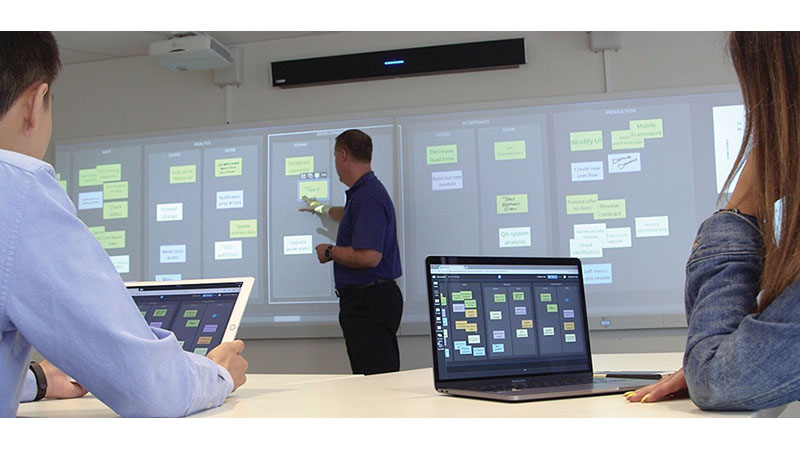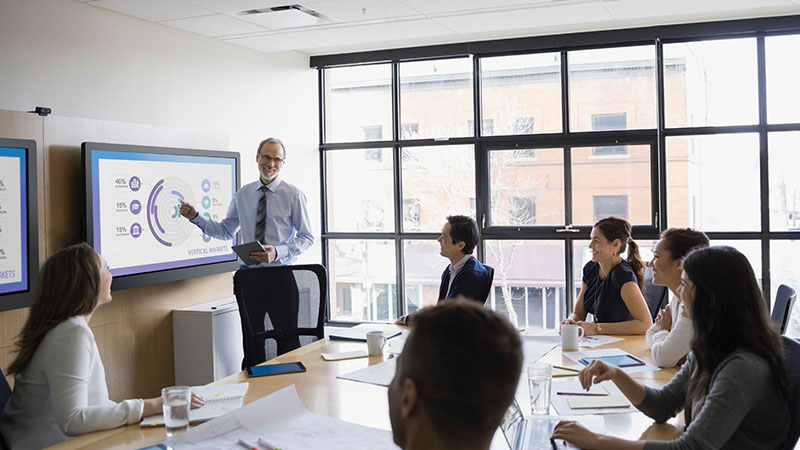Soft codecs—or enterprise-grade videoconferencing software options—are replacing hard codecs at a rapid clip. Solutions like Zoom, Skype for Business, and Cisco WebEx are rolling out across colleges and corporate campuses to help people engage, learn, and collaborate. Zoom, for example, has more than 700,000 business customers, including half of the companies in the Fortune 50 list. But where there are opportunities there are also challenges. The 2017 Forbes Insights report “The Connected Culture: Unleashing the Power of Video in Everyday Collaboration” discovered that “The existence of too many videoconferencing solutions in the workplace creates issues. The survey shows that 62 percent of companies are running three or more videoconferencing platforms, with nearly one in five (19 percent) running five or more.”

As teams become more remote and the BYOD needs grow, how can AV managers streamline a solution like Zoom while still offering high-quality audiovisual performance? How can “traditional” AV systems and acumen enhance the new generation of soft codecs?
REMOTE ON THE RISE
According to Dana Corey, GM of Avocor Global, “Remote working continues to be on the rise and always will be when you have a diversified workforce across multiple locations.” He underscored the many benefits of remote working, including a wide schedule for access, well beyond a typical workday. It also enables employers to hire the best people for a job, regardless of location.
“We also see an inverse, where large companies, such as Yahoo, are ending their work-from-home policy,” he said. “But Yahoo still has a massive need to provide the tools, resources, and security for remote working.”
THE GOOD—AND GOOD ENOUGH—NEWS
Rob Abbott, VP of products at Nureva, believes that the wider adoption of software-based UCC (unified communications and collaboration) systems is a positive step for collaboration. “Zoom, Skype, and WebEx—all of those solutions are definitely helping more people collaborate, and it’s something that we’re fully embracing.”
He sees specific benefits vis-à-vis the delivery of “good enough” videoconferencing where it is needed.
“Video delivered via Zoom and Skype with an inexpensive camera is ‘good enough’ for most scenarios with distributed people,” Abbott said.
CAN’T FIX BAD ROOMS
Cory Schaeffer, director of systems solutions, QSC, attended Zoomtopia 2018, the annual conference for Zoom users, where she observed a push toward “everything in a box.” For an executive conference room, there might be a box of equipment with everything you need for web conferencing. An all-hands training room would have a different equipment list.
While the “all-in-one” concept simplifies the process—and for a certain class of room, a DIY approach is appropriate—there are missed opportunities for a more robust and consequential discussion: how to improve rooms themselves. Many organizations have diverse layouts and architectural details. Even 12-by-12 rooms are not static environments. All spaces should be outfitted and/or treated to support dynamic work and real creativity. Poor audio brings ruinous effects. If a worker is sitting at home, trying to collaborate with her team at the company’s HQ, and poor acoustics disrupt her experience, her talents are not being utilized. She will waste time and energy trying to listen or decipher the conversation instead of actively contributing.
Good technology alone “cannot fix tough rooms,” Schaeffer added, or details such as glass walls, high ceilings, or highly reverberant finishes. We need to work with the facilities team prior to deployment to get input on the room and decide what technology will provide the best connected meeting room environment.
For Schaeffer, a notable takeaway from Zoomtopia was how to achieve maximum ease of use without sacrificing functionality. “Just as we join meetings at our desk, we should be as comfortable when we enter a huge training room or an all-hands room, and have the same comfort and functionality,” she said. “That’s why I love what the people at Zoom are doing—the concept of simplicity.”
Schaeffer added that QSC strives to make the audio, video, and control environment as natural as possible, with easy integration with the very popular ceiling microphones that provide excellent pickup. The more intelligible and seamless a conversation can be, the deeper the engagement and overall productivity. This is where the integrated AV expertise can make a difference.
DROP THE ‘REMOTE’
Rob Abbott believes that to usher in the next phase of UCC, we should reflect on how we talk about work culture. Using terms such as an “onsite” and “remote” employee is “the wrong way of thinking about it, because that already classifies a ‘remote worker’ as a second-class citizen,” he said.
He explained that, in 2019, we need to assume that when a group meets, not all team members will not all be in the same space. Therefore, the notion of distribution needs to be baked into the core design of spaces and rooms, as well as the technology and the software that supports the space.
While there will always be a need for teams to gather in physical space, such as the boardroom, quick decision-making and the nature to today’s work requires impromptu meetings. Companies are under increasing pressure to get projects done quicker, and to have better ideas. Is the next breakthrough idea from the person in the satellite office, a huddle space, or in the open area?
“The fundamental design of spaces should expect a certain level of messiness,” Abbott said. “Too often, the way a space is set up assumes the lowest common denominator [of collaboration], such as a group of people sitting and staring at the center of the table.” As soon as any real, meaningful work starts to happen, however, the technology breaks down, or someone is lost from the field of view. And the nature of meetings is “continually getting messier,” he said. “It’s a core premise at Nureva that every meeting will be dynamic in some way, and it will include people who are not in the same facility.”
SELECTING A SOLUTION
With a surfeit of soft codecs available, it is wise to consider technology that can be as future-proofed and scalable as mobile phone platforms. Explore which vendors have roadmaps that show forethought and scalability. Many AV professionals believe the model of functionality triggered by a hardware ad-on is indeed outdated. Explore which models can provide seamless updates of firmware or software, or cloud updates. Also, service options need to meet the unique needs of your end users and venue.
“Combined with the omnipresent desire for increased collaboration and effective communication, both across the table and across the globe, we apply these needs into making a very simple-to-use, effective solution,” said Dana Corey. “Something that is as seamless as a laptop or phone—that you don’t even notice it or have apprehension to use it because it’s so intuitive and helpful toward connecting teammates.”
He explained that Avocor works with both Zoom and Skype, and is “Zoom Room certified,” meaning that the company provides native integration into Zoom, so it’s easy to walk in a room and join, start, or schedule a Zoom meeting. Avocor also works closely with Microsoft, most notably with the launch of the world’s first Windows collaboration display, according to the company.
QSC announced in 2018 that it had been awarded a utility patent for its Q-SYS Web Conference Integration Solution. This patent recognizes the solution’s ability to bring an IP camera stream from Q-SYS PTZ-IP conference cameras into soft-codec applications (like Zoom, Skype for Business, GoToMeeting, etc.) via a driverless USB connection.
NEW OPPORTUNITIES: FIND THE RIGHT RECIPE
Let’s face it: most ad hoc videoconferences still leave much to be desired. “I think the AV specialist’s job is to connect the dots between the available technologies to extend UCC clients and deliver a consistent, expected experience,” Abbott said.

For many, the real opportunity within the new age of codecs is adding value and delivering excellence. The AV expert can put the right ingredients together and find the best recipe for each type of room to meet specific user needs. Whether the recipe involves off-the-shelf equipment, acoustic treatments, or external components for improved intelligibility, the opportunities are as diverse as the spaces themselves.
Margot Douaihy is the Editor-at-Large of AV Technology.
Info
